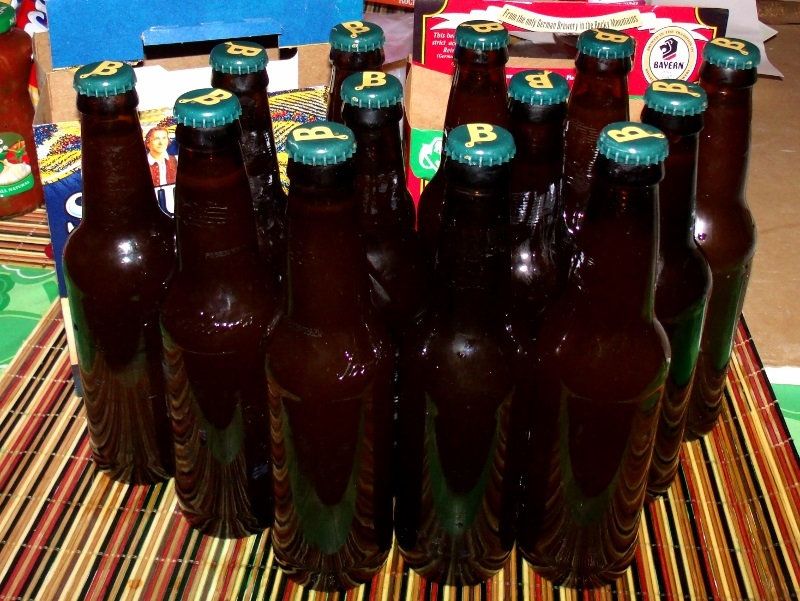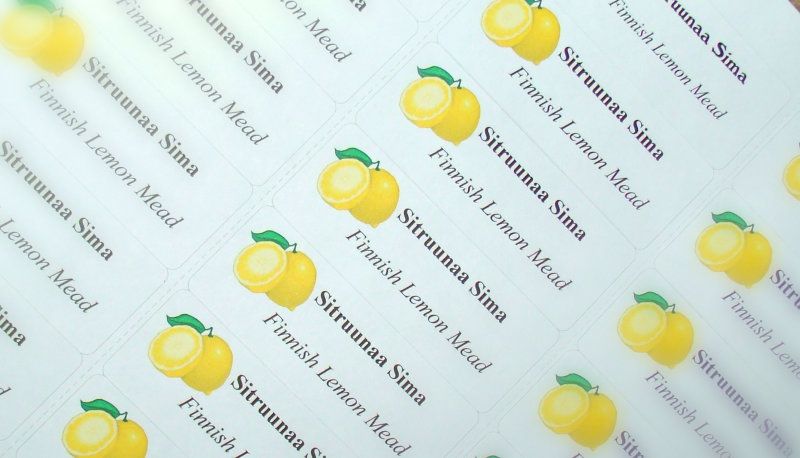TasunkaWitko
Well-Known Member
It's that time of year again - I'll probably be starting a batch of sima this weekend for Finland's Vappu Festival on May first. This traditional lemon mead from Finland is easy, it tastes great and it's a fun way to involve yourself in a tradition from another land.
Here's the recipe, along with step-by-step photos and random (hopefully-helpful) notes that I've taken as I have learned more about this mead over the past few years:
More on sima from WikiPedia:
Regarding the Vappu festival:
In my research, I came across several recipes for sima. All used a combination of white and brown sugar rather than honey; this leads me to believe that the FOTW recipe is accurate, traditional and sovereign.
So, folks - in honor of Vappu, I am making a 5-quart batch of the traditional Finnish mead known as sima, which uses white and brown sugars rather than honey and is brewed in Finland to celebrate the Vappu festival on May Day, which commemorates the coming of spring.
Here's the goods:
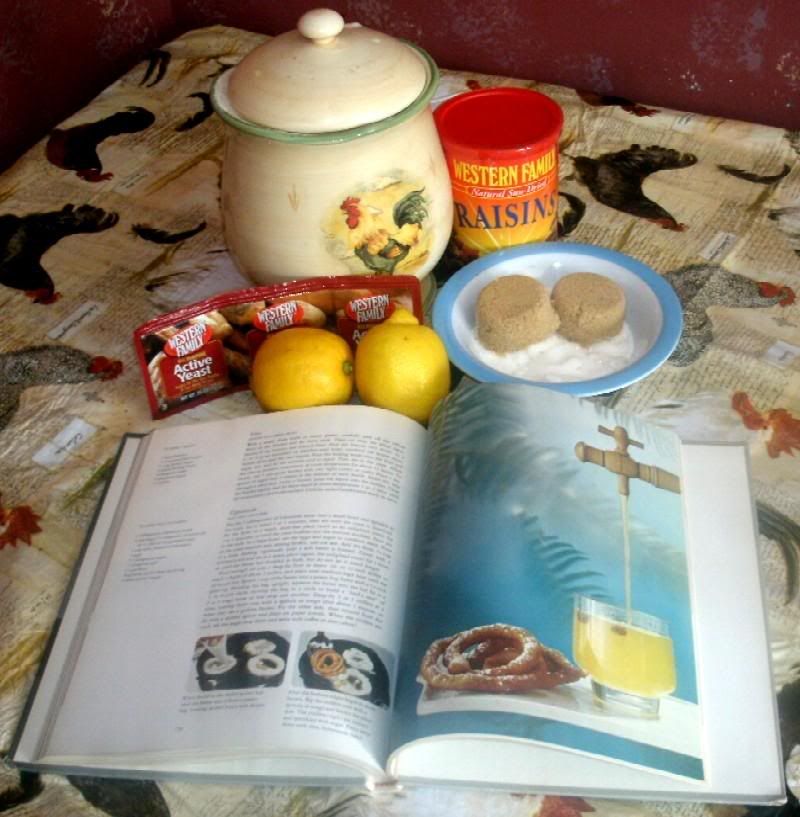
After boiling the water and sterilising the jars, I sliced the lemons:
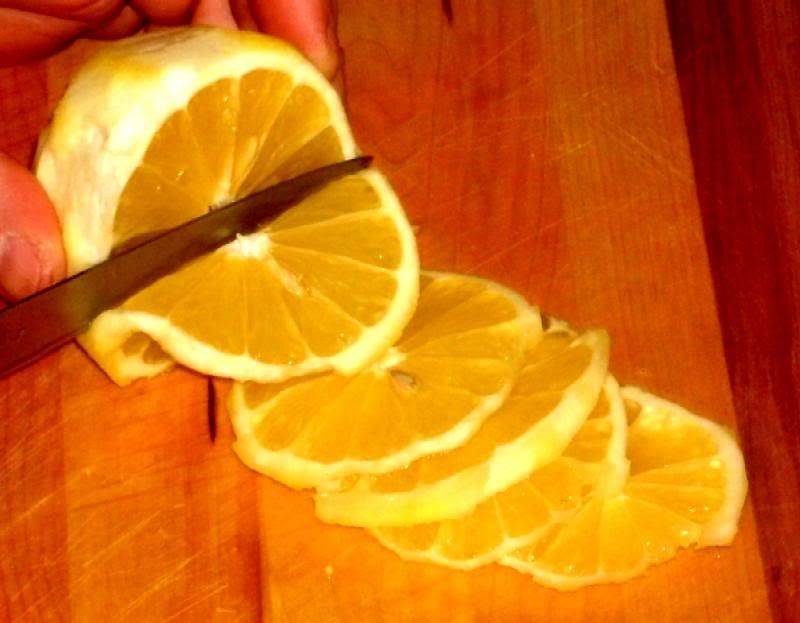
Next, I cut all the pith off the slices and then added the boiling water.
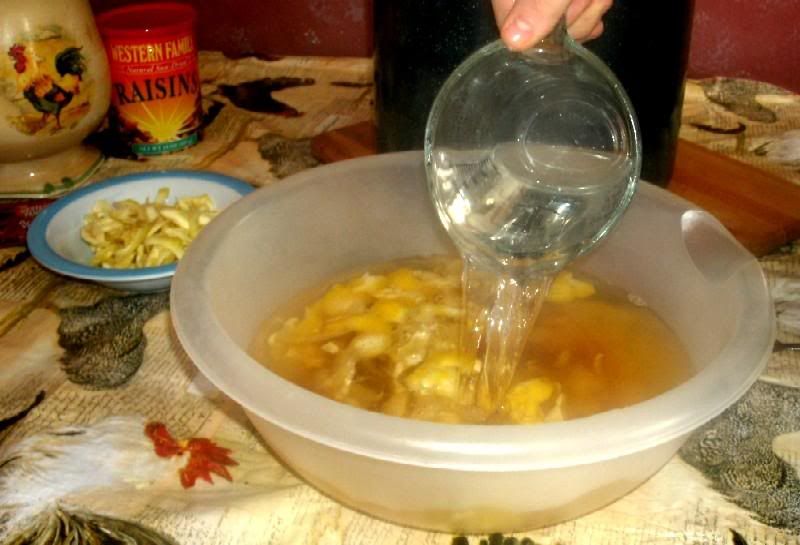
I then stirred the mixture around to dissolve the sugars:
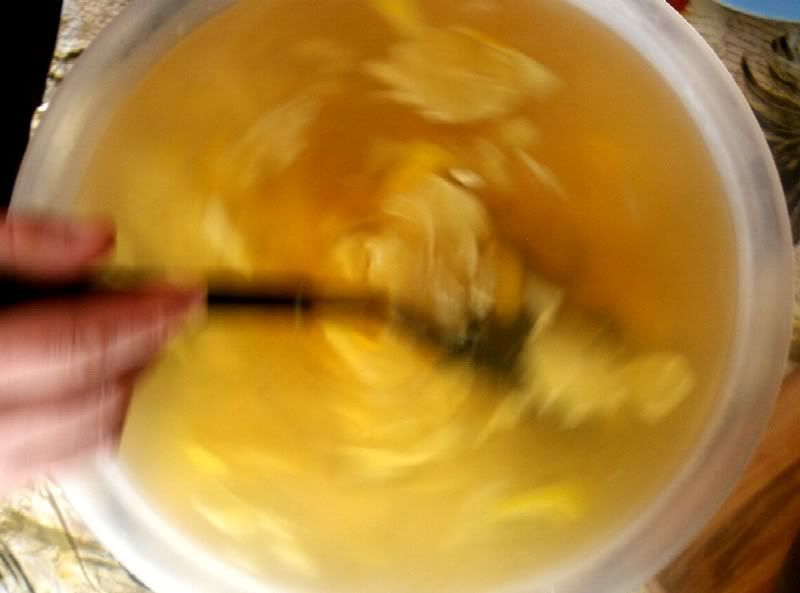
And let the mix settle and and cool to the point where I could add the yeast.
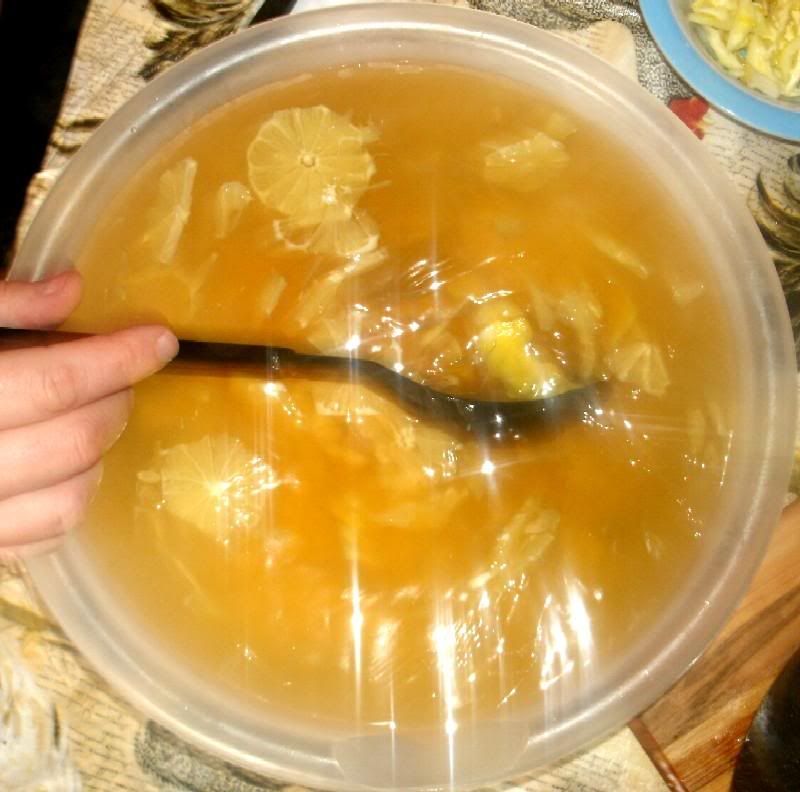
Now, it's time to let it ferment and then it will go in the mason jars (or some other suitable container)!
(The next day)
I poured the sima into mason jars as described in the recipe. Most of them have their raisins floating at the top by now, but one actually has the raisin suspended in mid-jar, as of this morning. we'll see how it looks tonight!
(2 days later)
I decided to add a little bit of sugar to the jar where the raisins had only risen partway. This jar came up a little short when I filled them and I ended up topping it off with water, which could be the reason for the apparent lack of fermentation. Hopefully, adding the sugar (I added about the equivalent of two cubes) will fix this.
(1 May 2010 -Vappu!)
I cracked this open and I couldn't believe how good this was! Clear, refreshing, effervescent and lemony; not sweet, but not bitter, either - just right!
The very first time I made this, it seemed a little bitter, so this time I had resolved to get every bit of white pith out of the lemons possible. In order to do this, I zested the lemons rather than peeling them, then cut off all pith from the lemon slices. this paid off in a big way!
(A little over a year later)
I've noticed that the longer sima ages, the better it is, I've got one jar left that is a little over a year old and it is definitely nice, lemony and smooth!
(2013)
The sima turned out really good ~ very fizzy with a nice "beer-y" taste and great "lemon-y" highlights. It would actually make a great, refreshing beverage on a hot summer day, and I can just see myself sipping this while enjoying an afternoon of barbecuing or fishing.
As mentioned above, it was a bit darker than normal due to my use of dark brown sugar. I can't say for sure that the dark brown sugar added anything to the experience, but it sure didn't hurt, either.
(2014)
For what it's worth, I have checked with a new friend in Finland, and he said that sima is indeed a mead made from sugar rather than honey; he suggested all brown sugar (rather than a combination of white and brown) for a fuller flavour.
Here's the recipe, along with step-by-step photos and random (hopefully-helpful) notes that I've taken as I have learned more about this mead over the past few years:
Sima
Traditional Lemon-Flavored Mead from Finland
From Time-Life's: Foods of the World - The Cooking of Scandinavia, 1968:
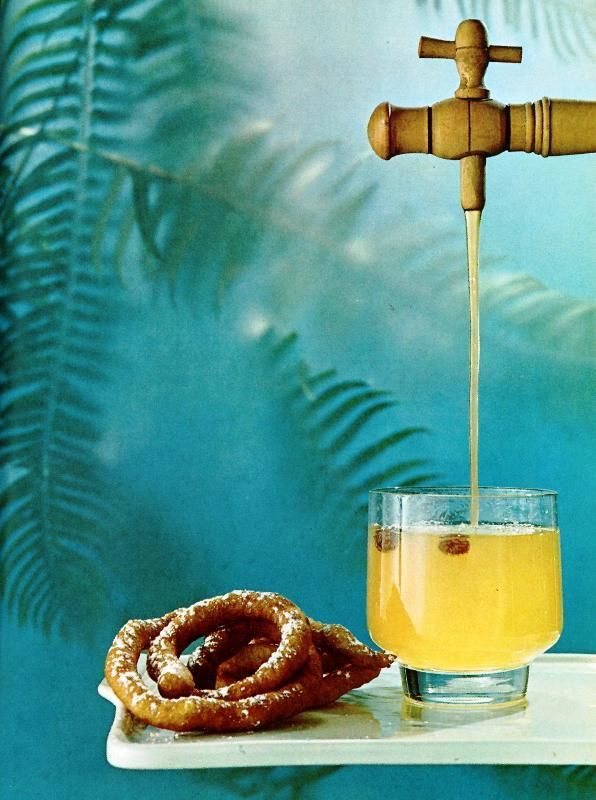
2 large lemons
1/2 cup granulated sugar
1/2 cup brown sugar
5 quarts boiling water
1/8 tsp. yeast
5 tsp. sugar
15 raisins
With a small, sharp knife or rotary peeler, carefully peel off the yellow skins (zest) and set them aside; then cut away the white membranes of the lemons and discard them. Slice the lemons very thinly.
In a 6- to 8-quart enameled or stainless steel bowl, combine the lemon slices, lemon zest and the two sugars. pour the boiling water over the fruit and sugar, stir and let the mixture cool to tepid; then stir in the yeast. Allow the sima to ferment, uncovered, at room temperature for about 12 hours.
To bottle, use five 1-quart bottles with very tight covers or corks. Place one teaspoon of sugar and three raisins in the bottom of each bottle. Strain the sima through a sieve and, using a funnel, pour the liquid into the bottles. Close the bottles tightly and let them stand at room temperature one to two days, until the raisins have risen to the surface. Chill the sealed bottles until ready to serve.
More on sima from WikiPedia:
Sima is a sweet mead, still an essential seasonal, sparkling brew connected with the Finnish Vappu festival. It is usually spiced by adding both the flesh and rind of a lemon. During secondary fermentation raisins are added to control the amount of sugars and to act as an indicator of readiness for consumption they will swell by absorbing carbon dioxide and rise to the top of the bottle when the drink is ready. Sima is usually accompanied by munkki (a donut), tippaleipä (a special Vappu funnel cake) or rosetti (a rosette).
Ingredients for sima include Lemon, sugar, active dry yeast, and raisins. The concoction of water and the lemon and sugars are mixed, boiled , and cooled to room temperature (25'C or 75'F). The yeast is added and the mixture left to stand overnight. The sima will be ready to drink when the raisins rise to the top of the bottles, about 3-7 days depending on the temperature of the room where they are stored. It is usually served chilled.
Regarding the Vappu festival:
Walpurgis Night (Walpurgisnacht) is a traditional religious holiday of pre-Christian origin, celebrated today by Christian as well as non-Christian[citation needed] communities, on April 30 or May 1 in large parts of Central and Northern Europe.[1]
The current festival is, in most countries that celebrate it, named after Saint Walpurga, born in Devon about 710. Due to the coincidence of her holy day falling on the same day as the pagan holiday on which it was based, her name became associated with the celebrations. Walpurga was honored in the same way that Vikings had celebrated spring and as they spread throughout Europe, the two dates became mixed together and created the Walpurgis Night celebration. Early Christianity had a policy of 'Christianising' pagan festivals so it is perhaps no accident that St. Walpurga's day was set to May 11....
Historically Walpurgisnacht is derived from various pagan spring customs. Bonfires were built to keep away the dead and chaotic spirits that were then widely believed to walk among the living.[2] This is followed by the return of light and the sun as celebrated during May Day, although bonfires and witches are more closely associated with Easter (especially in Ostrobothnia, Finland) and bonfires alone with midsummer in the rest of Finland.
Saint Walpurga was a niece of Saint Boniface and, according to legend, daughter of St. Richard, a Saxon prince. She travelled with her brothers to Franconia, Germany, and became a nun in the convent of Heidenheim, Bavaria, which was founded by her brother Willibald. Shortly after moving the mortal remains of her brother,[3] Saint Winibald, Walpurga died of an illness on 25 February 779. She is therefore listed in the Roman Martyrology under 25 February. So that she might be buried beside Willibald, her relics were transferred on 1 May, and this date remains associated with her in the Finnish and Swedish calendars....[3][4]
In Finland, Walpurgis day (Vappu) is, along with New Year's Eve and Juhannus, the biggest carnival-style festival held in the streets of Finland's towns and cities. The celebration, which begins on the evening of April 30 and continues to May 1, typically centers on copious consumption of sparkling wine and other alcoholic beverages....One tradition is drinking homemade sima (mead) (whose alcohol content varies) along with freshly cooked doughnuts.
In my research, I came across several recipes for sima. All used a combination of white and brown sugar rather than honey; this leads me to believe that the FOTW recipe is accurate, traditional and sovereign.
So, folks - in honor of Vappu, I am making a 5-quart batch of the traditional Finnish mead known as sima, which uses white and brown sugars rather than honey and is brewed in Finland to celebrate the Vappu festival on May Day, which commemorates the coming of spring.
Here's the goods:

After boiling the water and sterilising the jars, I sliced the lemons:

Next, I cut all the pith off the slices and then added the boiling water.

I then stirred the mixture around to dissolve the sugars:

And let the mix settle and and cool to the point where I could add the yeast.

Now, it's time to let it ferment and then it will go in the mason jars (or some other suitable container)!
(The next day)
I poured the sima into mason jars as described in the recipe. Most of them have their raisins floating at the top by now, but one actually has the raisin suspended in mid-jar, as of this morning. we'll see how it looks tonight!
(2 days later)
I decided to add a little bit of sugar to the jar where the raisins had only risen partway. This jar came up a little short when I filled them and I ended up topping it off with water, which could be the reason for the apparent lack of fermentation. Hopefully, adding the sugar (I added about the equivalent of two cubes) will fix this.
(1 May 2010 -Vappu!)
I cracked this open and I couldn't believe how good this was! Clear, refreshing, effervescent and lemony; not sweet, but not bitter, either - just right!
The very first time I made this, it seemed a little bitter, so this time I had resolved to get every bit of white pith out of the lemons possible. In order to do this, I zested the lemons rather than peeling them, then cut off all pith from the lemon slices. this paid off in a big way!
(A little over a year later)
I've noticed that the longer sima ages, the better it is, I've got one jar left that is a little over a year old and it is definitely nice, lemony and smooth!
(2013)
The sima turned out really good ~ very fizzy with a nice "beer-y" taste and great "lemon-y" highlights. It would actually make a great, refreshing beverage on a hot summer day, and I can just see myself sipping this while enjoying an afternoon of barbecuing or fishing.
As mentioned above, it was a bit darker than normal due to my use of dark brown sugar. I can't say for sure that the dark brown sugar added anything to the experience, but it sure didn't hurt, either.
(2014)
For what it's worth, I have checked with a new friend in Finland, and he said that sima is indeed a mead made from sugar rather than honey; he suggested all brown sugar (rather than a combination of white and brown) for a fuller flavour.




































![Craft A Brew - Safale BE-256 Yeast - Fermentis - Belgian Ale Dry Yeast - For Belgian & Strong Ales - Ingredients for Home Brewing - Beer Making Supplies - [3 Pack]](https://m.media-amazon.com/images/I/51bcKEwQmWL._SL500_.jpg)






















